Accustic Arts Power III Integrated Amplifier by Terry London
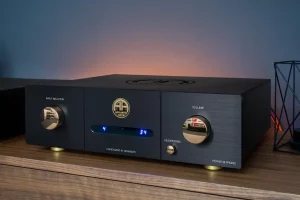
 In 2006, I started to write lay reviews for the forums on the AudioGon website for fun. That was also the period of writing a string of reviews on Accustic Arts DACs, transports, and preamplifiers, which I owned and enjoyed very much. This led to two pursuits in the last eighteen years: First, because of my reviews on AudioGon, I was offered a position to become a professional staff reviewer on a well-known website. All these years later, and with over 200 reviews, I still enjoy reviewing and sharing information on different types of stereo gear. Secondly, based on my experience with Accustic Arts gear, I became a fan of this German-based company’s wonderful electronics.
In 2006, I started to write lay reviews for the forums on the AudioGon website for fun. That was also the period of writing a string of reviews on Accustic Arts DACs, transports, and preamplifiers, which I owned and enjoyed very much. This led to two pursuits in the last eighteen years: First, because of my reviews on AudioGon, I was offered a position to become a professional staff reviewer on a well-known website. All these years later, and with over 200 reviews, I still enjoy reviewing and sharing information on different types of stereo gear. Secondly, based on my experience with Accustic Arts gear, I became a fan of this German-based company’s wonderful electronics.
 Just around that period, around 2010, the US importer for Accustic Arts went away, and the footprint that the company was gaining among American audiophiles started to dwindle to a very occasional US-based review and seldom any discussions on the different audio forums. Accustic Arts during this period was always highly regarded in Europe and Asia and received many accolades and awards from many reviewers in those markets. Because of my history with Accustic Arts equipment, I thought the time had come to see if I could set up a review of one of their current pieces. I contacted the current Accustic Arts USA distributor, Rutherford Audio, Inc., in Englewood, Colorado. My contact at Rutherford Audio was Robb Niemann, who was a pleasure to work with to make this review possible. The Power III Integrated amplifier, which retails for $18,500 and has both an internal DAC and an MM/MC phono stage, would be the subject of this review. You can purchase the Power III Integrated amplifier without the phono-stage for $16,500 if you no longer spin vinyl in your system.
Just around that period, around 2010, the US importer for Accustic Arts went away, and the footprint that the company was gaining among American audiophiles started to dwindle to a very occasional US-based review and seldom any discussions on the different audio forums. Accustic Arts during this period was always highly regarded in Europe and Asia and received many accolades and awards from many reviewers in those markets. Because of my history with Accustic Arts equipment, I thought the time had come to see if I could set up a review of one of their current pieces. I contacted the current Accustic Arts USA distributor, Rutherford Audio, Inc., in Englewood, Colorado. My contact at Rutherford Audio was Robb Niemann, who was a pleasure to work with to make this review possible. The Power III Integrated amplifier, which retails for $18,500 and has both an internal DAC and an MM/MC phono stage, would be the subject of this review. You can purchase the Power III Integrated amplifier without the phono-stage for $16,500 if you no longer spin vinyl in your system.
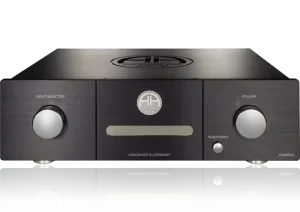
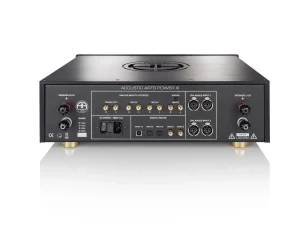
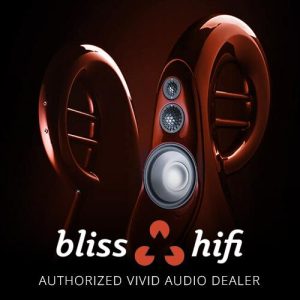 The Accustic Arts Power III Integrated amplifier arrived in a flight case that ensured the safety of the enclosed unit. My first impression, after easily unpacking the Power III integrated amplifier, was the piece’s striking, drop-dead gorgeous appearance. My review sample was black with silver front knobs. The thick aluminum plates were seamlessly bolted together. The top plate had a beautifully engraved Accustic Arts emblem backlit by internal blue LEDs. The quality of German engineering was on full display regarding the materials and craftsmanship of the construction of the chassis of the Power III Integrated amplifier—the Power III Integrated weighs 50.7 pounds. At the same time, the Power III dimensions are a Height of 5.7′ x Width of 19′ x depth of 17.3′. The front panel has two knobs. whOne controls the input, the other volume. In the center is the blue LED-based screen, which shows what input is engaged and the volume level setting. On the bottom right is a headphone output. The inputs (2 x XLR -3 X RCA) are located in the back panel. Alongside these main inputs are a series of analog inputs and digital connections. There is a grounding post for turntables. A pair of very high-quality speaker binding posts, which can be used with spades or banana connectors, are located on the sides of the back plate. Finally, the IEC input and master on/off power switch are located on the bottom right on the back of the unit. The remote control is solidly built out of aluminum with excellent ergonomics that can control all the Power III’s functions without having to go to the front panel knobs for adjustments.
The Accustic Arts Power III Integrated amplifier arrived in a flight case that ensured the safety of the enclosed unit. My first impression, after easily unpacking the Power III integrated amplifier, was the piece’s striking, drop-dead gorgeous appearance. My review sample was black with silver front knobs. The thick aluminum plates were seamlessly bolted together. The top plate had a beautifully engraved Accustic Arts emblem backlit by internal blue LEDs. The quality of German engineering was on full display regarding the materials and craftsmanship of the construction of the chassis of the Power III Integrated amplifier—the Power III Integrated weighs 50.7 pounds. At the same time, the Power III dimensions are a Height of 5.7′ x Width of 19′ x depth of 17.3′. The front panel has two knobs. whOne controls the input, the other volume. In the center is the blue LED-based screen, which shows what input is engaged and the volume level setting. On the bottom right is a headphone output. The inputs (2 x XLR -3 X RCA) are located in the back panel. Alongside these main inputs are a series of analog inputs and digital connections. There is a grounding post for turntables. A pair of very high-quality speaker binding posts, which can be used with spades or banana connectors, are located on the sides of the back plate. Finally, the IEC input and master on/off power switch are located on the bottom right on the back of the unit. The remote control is solidly built out of aluminum with excellent ergonomics that can control all the Power III’s functions without having to go to the front panel knobs for adjustments.
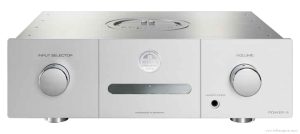
The Accustic Art Power III Integrated amplifier will drop 230 watts into 8 ohms, 370 watts into 4 ohms, and 510 watts into 2 Ohms. An amplifier must have a robust power supply to be stable and increase its wattage to very low 2 Ohm loads. The Power III uses a 600VA toroidal core transformer with an 80,000 capacitance power supply, allowing it to effortlessly drive difficult speakers with low impedance ratings. The amplifier’s output devices are 12 highly selected Bipolar transistors. The internal DAC is based on the highly regarded Sabre ESS 9026 DAC chip. For more details and specifications on the Power III, I recommend you go to Accustic Art’s website.
.jpg?KeepThis=true&TB_iframe=true&height=430&width=700) Before I get into the details of why I listened to hours of music through the Accustic Arts Power III Integrated amplifier with great pleasure, I want to mention what I will not comment on regarding its performance. Since I used no analog sources, I could not evaluate Power III’s phono section. Secondly, I am not a headphone user so that no judgment can be rendered on its headphone section. I did investigate the performance of its internal DAC. It is at least on par with the DACs I have reviewed, priced in the $3000 to $6000 range. It offers excellent clarity, tonality, above-average sound staging, and dynamics. It was what I expected from an excellent Sigma Delta-based DAC chip. My taste is still in the camp of R2R ladder chip-based convertors because their presentation is warmer and more natural sounding with greater image density. Therefore, all my following comments on the performance of the Accustic Arts Power III Integrated amplifier are based on using my reference Reimyo Tuko DAC driven by a Mark Levinson 31.5 transport.
Before I get into the details of why I listened to hours of music through the Accustic Arts Power III Integrated amplifier with great pleasure, I want to mention what I will not comment on regarding its performance. Since I used no analog sources, I could not evaluate Power III’s phono section. Secondly, I am not a headphone user so that no judgment can be rendered on its headphone section. I did investigate the performance of its internal DAC. It is at least on par with the DACs I have reviewed, priced in the $3000 to $6000 range. It offers excellent clarity, tonality, above-average sound staging, and dynamics. It was what I expected from an excellent Sigma Delta-based DAC chip. My taste is still in the camp of R2R ladder chip-based convertors because their presentation is warmer and more natural sounding with greater image density. Therefore, all my following comments on the performance of the Accustic Arts Power III Integrated amplifier are based on using my reference Reimyo Tuko DAC driven by a Mark Levinson 31.5 transport.
Regardless of what music genre I played through the Power III, the first quality I clearly and easily heard was an overall silky smoothness and effortless liquidity that allowed me to relax into the music completely. Make sure to distinguish this from a euphonic presentation with a lack of dynamics or PRAT. On the contrary, the Power III could deliver huge dynamic swings at high volume levels and never lose its effortless composure. An album that demonstrated these qualities was Telarc’s “Orchestral Spectaculars” by Erich Kunzel, who conducted the Cincinnati Pops Orchestra. When the orchestra reached ultimate crescendos, these peaks were tracked by the Power III with great accuracy, as were the quietest micro-details.
 If you are a reader of my past reviews, you will already know that the most essential ingredient for my musical palate is timbres/tonality/tone. If a piece of equipment botches this aspect of fidelity, even if it gets dynamics and spatial aspects correctly, it’s a deal breaker for me. I used the beautifully recorded Groove Note album “Fire & Rain” by the jazz singer Jacintha to see how the Accustic Art Power III Integrated amplifier would deal with the timbres/tonality of her unique voice. I heard a realistic three-dimensional Jacintha standing in the middle of my listening space, and her rich golden voice was rendered with a density of color and an overall delicacy and sweetness. The Power III is at a reference level in this sonic domain.
If you are a reader of my past reviews, you will already know that the most essential ingredient for my musical palate is timbres/tonality/tone. If a piece of equipment botches this aspect of fidelity, even if it gets dynamics and spatial aspects correctly, it’s a deal breaker for me. I used the beautifully recorded Groove Note album “Fire & Rain” by the jazz singer Jacintha to see how the Accustic Art Power III Integrated amplifier would deal with the timbres/tonality of her unique voice. I heard a realistic three-dimensional Jacintha standing in the middle of my listening space, and her rich golden voice was rendered with a density of color and an overall delicacy and sweetness. The Power III is at a reference level in this sonic domain.
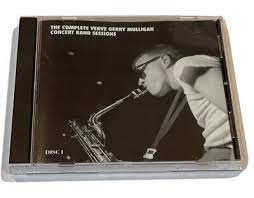 My last selection was the Mosaic album of the great baritone saxophonist Gerry Mulligan’s “Concert Band Sessions Volume 1”. I use this recording to get an amplifier’s ability to create, if it’s on the recording, a sound stage with depth/height/width along with accurate placement of individuals on that sound stage, and if it can produce a sense of air around these individuals players. My speakers completely disappeared into an immense soundstage with rock-solid/holographic images of the band’s players as each took turns soloing.
My last selection was the Mosaic album of the great baritone saxophonist Gerry Mulligan’s “Concert Band Sessions Volume 1”. I use this recording to get an amplifier’s ability to create, if it’s on the recording, a sound stage with depth/height/width along with accurate placement of individuals on that sound stage, and if it can produce a sense of air around these individuals players. My speakers completely disappeared into an immense soundstage with rock-solid/holographic images of the band’s players as each took turns soloing.
Many times during my auditioning of the Accustic Arts Power III Integrated amplifier, I said I would only listen for a reasonable amount of time, which then turned into hours of blissful music enjoyment. Think of all the stellar qualities of this German-designed and manufactured integrated amplifier. A beautiful physical appearance, high-level internal parts, construction, reference-level reproduction of gorgeous timbres/tonality, seemingly boundless dynamics, the ability to create a sense of spatiality that captures how authentic music sounds, and an accurate fidelity that gives you the illusion of live music. The Accustic Arts Power III Integrated amplifier was a real treat to review, and I hope this review will spark interest in US audiophiles. Welcome back to America.
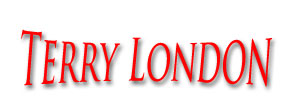

Specifications:
Price: $18500
Inputs:
2 x balanced high level inputs (XLR) 3 x unbalanced high level inputs (RCA/Chinch); 1 x unbal. Input (RCA/Cinch) either as high level input, alternatively as “SURROUND-BYPASS or as phono input (input “3”) 5 x digital inputs; 2 x S/P-DIF; coaxial 192 Khz / 24 Bit, 2 x optical S/P-DIF 96kHz 24Bit, USB: DSD 512 (32 Bit / 384 kHz for PCM)
Headphones output:
1 x metal female jack 6.3 mm; > 25 Ω
Outputs:
1 x unbalanced pre-output (RCA); 47 Ω
Signal difference left/right:
< 0.2 dB (from 0 dB to -20 dB)
Input resistance:
balanced: 2 x 50 kΩ
unbalanced: 50 kΩ
Total transformer power:
max. 600 VA (watts)
Power supply capacity:
more than 80,000 µF
Rated power output (at THD+N = 0.1 %) at 10 watts power output
2 x 510 watts on 2 Ω
2 x 370 watts on 4 Ω
2 x 230 watts on 8 Ω
USA Distributor: Rutherford Audio Inc.
14 Inverness Drive East, Unit G-108
Englewood CO 80112
Phone: +1 888 279 6765
E-mail: info@rutherfordaudio.com
Website: www.rutherfordaudio.com
Terry’s Associated Equipment:
Sources:
Mark Levinson 31.5 transport
Pro-Jet reference CD transport & Linear Tube Audio power supply
CEC-belt driven transport
Pass Labs –DAC1
Reimyo TUKO-DAC
Amplification:
Coda #16 amplifier
Coda FET 07x preamplifier
SPL Elector preamplifier
SPL S1200 amplifier
AricAudio SET 300B amplifier
AricAudio Motherlode MKII preamplifier
Loudspeakers:
NSMT System Two
Tekton Design Ulberth
Accessories:
Black Cat Cable- Digit 110 AES/EBU-3202 XLR ICs
Kirmuss Audio Adrenaline speaker wire
Krolo Design reference rack & footers
Lateral Audio- Arena APX Isolation Device
Puritan Audio Conditioner & circuit grounding system
Audio Archon power cords
Stereo Times Masthead
Publisher/Founder
Clement Perry
Editor
Dave Thomas
Senior Editors
Frank Alles, Mike Girardi, Russell Lichter, Terry London, Moreno Mitchell, Paul Szabady, Bill Wells, Mike Wright, and Stephen Yan,
Current Contributors
David Abramson, Tim Barrall, Dave Allison, Ron Cook, Lewis Dardick, John Hoffman, Dan Secula, Don Shaulis, Greg Simmons, Eric Teh, Greg Voth, Richard Willie, Ed Van Winkle, Rob Dockery, Richard Doran, and Daveed Turek
Site Management Clement Perry
Ad Designer: Martin Perry






Be the first to comment on: Accustic Arts Power III Integrated Amplifier by Terry London